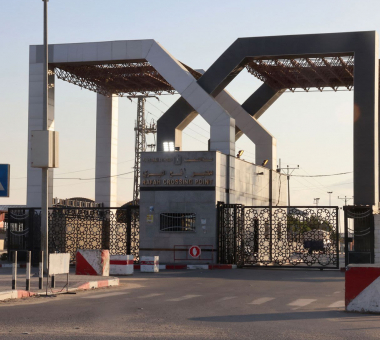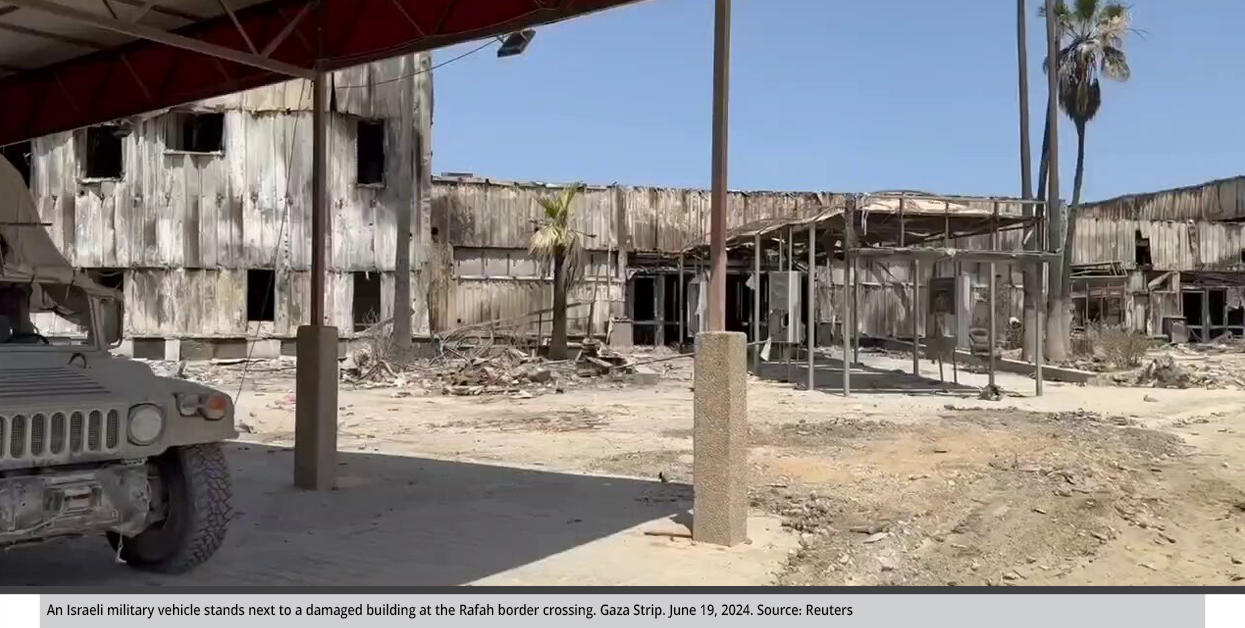The Rafah Crossing: Who Will Control It and Why It’s Important
The Rafah border crossing gains its significance on the world stage from being the only gateway into and out of the Gaza Strip for both its citizens and the delivery of life-saving goods and humanitarian aid. This paper presents future scenarios for the management of the crossing, which could be an issue with the arrangements for the day after the war or what may be proposed for implementation beforehand that will serve as a prelude to the future management structure of the Gaza Strip.
by STRATEGIECS Team
- Release Date – Aug 15, 2024

The Rafah border crossing ceased operations for travelers and aid entry after the Israeli army announced its control over the Palestinian side of the crossing on May 7 this year, coinciding with the start of the Israeli military operation in Rafah city. The crossing remains closed due to both the destruction it suffered and the failure to reach a mechanism agreed upon by all parties to resume its operation.
Accordingly, this paper presents scenarios for the future management of the Rafah crossing, noting that it may be part of the arrangements for the day after the war or it could be proposed for implementation beforehand, serving as a prelude to the post-war management structure of the Gaza Strip. Therefore, these scenarios remain dependent on the field and political conditions and their outcomes, as well as the extent to which regional and international powers agree on the Israeli proposals and the established positions of the Palestinians and Egyptians.
Israeli Actions in Rafah
The Rafah crossing holds significant importance as the Gaza Strip’s only gateway for civilian travel and the entry of goods and humanitarian aid. The crossing has gone through several phases since 1967 when Israel reoccupied it after the war and thus isolated it from the Egyptian side. However, after the Egypt-Israel peace treaty, Tel Aviv returned control of the crossing to Egypt. Following the 2005 disengagement plan, “Agreement on Movement and Access,” the crossing’s management on the Palestinian side of its border was handed over to the Palestinian Authority under European monitoring. Hamas, however, has managed the crossing since it took full control of the Gaza Strip in 2007.
After the outbreak of war on October 7, 2023, Israel has significantly undermined the crucial role of the Rafah crossing in supplying the Gaza Strip with needed goods and humanitarian aid by aligning it with its government’s war objectives, which included weakening Hamas’s ability to govern, controlling Gaza, and disarming the Strip. Israel, claiming that the crossing was being used for terrorist purposes, is also striving to isolate Gaza civilians and hinder them from receiving water, fuel, food, medicine and other life-saving goods.
On October 9, 2023, Israeli Defense Minister Yoav Gallant announced that water, food, and fuel would not be allowed to enter the Gaza Strip. This edict coincided with Israel closing all crossings and gateways leading into Gaza, including the Beit Hanoun/Erez and Kerem Shalom crossings. Moreover, reported Israel’s Channel 12, the Israeli government warned Egypt that it would “bomb any trucks carrying aid to Gaza via the Rafah crossing.” Carrying through on its threat, the Israeli army has targeted the Rafah crossing and its surroundings multiple times since the war began. And on October 10, Israeli fighter jets bombed the crossing twice, leading to its closure and forcing trucks loaded with humanitarian aid for Gaza residents to retreat to the Egyptian city of Arish.
The Rafah crossing has become a central point in ceasefire negotiations and limited agreements. On October 21, 2023, in exchange for foreign passport holders being able to leave the Strip, Qatari mediation succeeded in allowing limited food to enter Gaza and the evacuation of a small number of injured civilians for treatment. Due to an increasing uproar of international pressure, Israel was forced to gradually ease its blockade on Gaza, allowing humanitarian aid to enter through Rafah under the condition that the aid be inspected and limited in quantity, giving Israel control over the type and amount of aid allowed to enter. This complicated the entry process as trucks had to make an extra 248-mile round trip between the Rafah and Nitzana crossings for inspection. Under the first ceasefire agreement, aid quantities increased and fuel was allowed in accordance with the agreement’s terms.
However, Israel’s severe restrictions on the crossing and the entry of aid severely impacted the unprecedented humanitarian situation in Gaza, causing an insufficiency of aid and triggering UN warnings of an “imminent famine” in Gaza. The inefficiency of air-dropped aid operations and the U.S. military’s failure to operate the seaport pier further worsened the situation, leading the Pentagon to remove the pier from Gaza’s coast on May 28.
The Israeli Return to the Crossing Since 2005
The Israeli army took control of the Rafah crossing on May 7 this year, beginning the start of its military operation in the city. Exactly one month later, on June 7, the Israeli army announced its operational control over the Philadelphi Corridor, which extends from the Kerem Shalom crossing to the shores of the Mediterranean Sea. Since then, the infrastructure of the crossing has undergone several changes, including the burning of its departure hall on June 18 that caused it to be “completely out of service,” reported the Hamas media office.
This was followed by the establishment of the David Corridor, which, running parallel to the Philadelphi Corridor, extends eight miles and connects Israel with Iraq through Syria. A road was also constructed from the Kerem Shalom crossing towards the Rafah crossing, coinciding with the revelation by Israel’s Channel 12 of Israel’s plan to rebuild the Rafah crossing at a new location near Kerem Shalom—in essence forming a tripartite border point between Egypt, Israel, and the Gaza Strip.

Israel aims to leverage this change in support of Israeli Prime Minister Benjamin Netanyahu’s released one-page document outlining his plan for the day after the war. The significance of the Rafah crossing lies in achieving security and economic control by imposing Israeli administrative, civil, and security oversight on the entire Gaza Strip and the aid entering it. This also extends to tools, agencies, and institutions involved in reconstruction. Israel seeks to undermine Hamas’s rule, with the crossing symbolizing its sovereignty over the Strip since it took power.
Additionally, the shift of civilian movement from Rafah to Kerem Shalom or a new Israeli-controlled crossing raises concerns about Israeli control over exactly who is allowed to enter or leave. For instance, Netanyahu’s announcement on July 29 to delay the travel of 150 children from the Gaza Strip to the United Arab Emirate for medical treatment, without providing a new date, was issued one day after the Majdal Shams incident.
Positions and Suggestions of the Parties
The Rafah crossing has remained closed for the fourth consecutive month due to all parties adhering to their positions regarding the current situation of the crossing. Rounds of negotiations between Israel, Egypt, and the United States aimed at reopening the crossing have failed. In early June, the three countries discussed the possibility of reopening the Rafah crossing, but they were unable to reach an agreement due to disagreements over the proposed managing authority.
On August 3, negotiations between the Israeli negotiating delegation and Egyptian officials stumbled over reaching an agreement on security arrangements at the Philadelphi Corridor and Rafah crossing. Israeli media revealed a dispute between the Israeli delegation and Netanyahu regarding the negotiating terms that hindered reaching an agreement. In a press release, the prime minister insisted on keeping the military in the Philadelphi Corridor in exchange for what Hamas wants, which is to regain control of the Gaza Strip and flood it with weapons.
On one hand, Israel insists on maintaining its military presence in the David Corridor and the Philadelphi Corridor. It aims to impose a de facto situation after destroying the crossing facilities of on the Palestinian side, either to relocate it or to build a new one. Israel rejects handing the crossing over to the Palestinian Authority. Instead, it proposes that its management be entrusted to a force it relies on and trusts, whether an international force or a UN mission involving a neutral Palestinian party not affiliated with Hamas or officially representing the Palestinian Authority.
On the other hand, Egypt and the PA reject the idea of managing the Rafah crossing in partnership with Israel. In fact, Cairo demands a complete Israeli withdrawal from the Palestinian side of the crossing and that a Palestinian party manage the crossing. Egypt also suggests reviving the European Union Border Assistance Mission to oversee the crossing’s operations, and it has denied any agreement to relocate or build an alternative crossing. In addition, in response to the humanitarian crisis in Gaza, Cairo had agreed with Washington to temporarily hand over aid at the Kerem Shalom crossing to the United Nations.
Meanwhile, the Palestinian Authority has also rejected Israeli conditions for reopening the crossing, and it opposes partial management of Gaza’s facilities without considering the return of the Palestinian authority to Gaza within the framework of a comprehensive and broad political process.
Rafah Crossing Management Scenarios
In light of the above and given the complexity and divergence of the parties’ positions, it can be said that the anticipated scenarios for managing the crossing are intertwined and phased. Each scenario may lead to the others due to their connection with political, negotiation, and field military developments. They are as follows.
- Continuation of the Current Situation
Current data suggest the likelihood that the Rafah crossing will remain non-operational, with aid continuing to be delivered through the Israeli-controlled Kerem Shalom crossing. This is due to Israel’s insistence on remaining in control of the Palestinian side of the Rafah crossing and Egypt’s refusal to reopen it while Israel’s presence remains there. Consequently, it is expected that the status quo will continue, with the crossing’s management ultimately linked to the day after the cessation of hostilities. This scenario is considered the most likely in the short term, at least until a ceasefire agreement is reached and its phases are implemented.
In the medium and long term, Israel’s return to full control of the crossing faces several constraints. Any change in the field situation in Rafah and the Philadelphi Corridor could breach the 2005 crossing agreement, which is an addition to the Egypt-Israel peace treaty. However, Israel is attempting to skirt this issue by controlling the entry and exit process in the Gaza Strip through its operational control via the David Passage and the new route connecting the Kerem Shalom and Rafah crossings.

- Reactivating the 2005 Crossings Agreement
This scenario involves returning to the 2005 “Agreement on Movement and Access” that had been in effect until Hamas’s takeover in 2007, following Israel’s disengagement from the Gaza Strip. Under this agreement, the Palestinian Authority managed the crossing with the European Union as a supervising observer.
This scenario is the most acceptable to Egypt and the United States. However, it faces three major challenges: previous European Union requirements; Israel’s objection to the Palestinian side being officially represented by the PA; and the refusal of Palestinian factions in Gaza, particularly Hamas, to accept any non-Palestinian administration of the Rafah crossing. They would, in fact, consider it a form of occupation. Nevertheless, this scenario is likely to be pursued after a ceasefire and as part of the plan for the day after the war.
- Empowering a Third Party
In this scenario, the management of the crossing would be handled by a multinational force or a UN mission involving a Palestinian party. This scenario is linked to Israel’s suggestions that an American security company, an international force, or a UN entity manage the crossing alongside a Palestinian party that is neither Hamas nor the Palestinian Authority.
This scenario is considered the least likely due to Egypt’s refusal to partner with an international force as well as Cairo’s insistence that the crossing must be operated by a Palestinian party managing it. Additionally, other Arab countries are expected to reject participation to avoid being accused of either collaborating with Israel or abetting in the diminishment of the Palestinian role. Furthermore, it is unlikely that Israel will find a suitable Palestinian party that is not affiliated with Hamas or the Palestinian Authority, especially given the previous failed attempts to activate village and clan links and transfer civil administration to local entities in the Gaza Strip.
- Back to the Future: Returning to Pre-May 2024
In this scenario, border operations would resume as they were before the Israeli military’s declaration of control over it. Despite this option facing opposition from Israel, which aims to undermine Hamas’s capabilities and neutralize its governance, it could still be a possibility, albeit with a slim chance, if a deal is reached leading to a complete Israeli military withdrawal from the Gaza Strip. This scenario would be considered transitional until an agreement is reached on forming a temporary national unity government to manage the Gaza Strip.

STRATEGIECS Team
Policy Analysis Team
 العربية
العربية